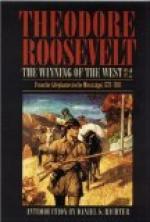Hamilton was urging the Indians to repeat their ravages of the preceding year; Mingos, Shawnees, Delawares, and Miamis came to Detroit, bringing scalps and prisoners. A great council was held at that post early in June. [Footnote: Do., June 14, 1778.] All the northwestern tribes took part, and they received war-belts from the Iroquois and messages calling on them to rise as one man. They determined forthwith to fall on the frontier in force. By their war parties, and the accompanying bands of tories, Hamilton sent placards to be distributed among the frontiersmen, endeavoring both by threat and by promise of reward, to make them desert the patriot cause. [Footnote: Do., April 25, 1778.]
Boon Escapes and Makes a Foray.
In June a large war party gathered at Chillicothe to march against Boonsborough, and Boon determined to escape at all hazards, so that he might warn his mends. One morning before sunrise he eluded the vigilance of his Indian companions and started straight through the woods for his home where he arrived in four days, having had but one meal during the whole journey of a hundred and sixty miles. [Footnote: Boon’s Narrative.]
On reaching Boonsborough he at once set about putting the fort in good condition; and being tried by court-martial for the capture at the Blue Licks, he was not only acquitted but was raised to the rank of major. His escape had probably disconcerted the Indian war party, for no immediate attack was made on the fort. After waiting until August he got tired of the inaction, and made a foray into the Indian country himself with nineteen men, defeating a small party of his foes on the Sciota. At the same time he learned that the main body of the Miamis had at last marched against Boonsborough. Instantly he retraced his steps with all possible speed, passed by the Indians, and reached the threatened fort a day before they did.
Boonsborough again Beseiged.
On the eighth day of the month the savages appeared before the stockade. They were between three and four hundred in number, Shawnees and Miamis, and were led by Captain Daigniau de Quindre, a noted Detroit partisan [Footnote: Haldimand MSS. Aug. 17, 1778, Girty reports that four hundred Indians have gone to attack “Fort Kentuck.” Hamilton’s letter of Sept. 16th speaks of there being three hundred Shawnees with de Quindre (whom Boon calls Duquesne).]; with him were eleven other Frenchmen, besides the Indian chiefs. They marched into view with British and French colors flying, and formally summoned the little wooden fort to surrender in the name of his Britannic Majesty. The negotiations that followed showed, on the part of both whites and reds, a curious mixture of barbarian cunning and barbarian childishness; the account reads as if it were a page of Graeco-Trojan diplomacy. [Footnote: See Boon’s Narrative.] Boon first got a respite of two days to consider de Quindre’s request, and occupied the




